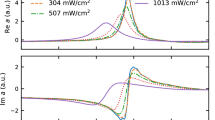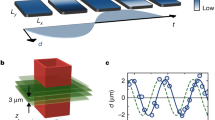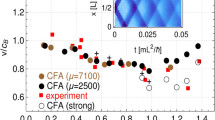Abstract
In this paper, temperature waves (also known as second sound) are considered, with their respective coupling with waves in the order parameter describing the transition from normal phase to superfluid phase, and with waves in the vortex length density. We analyze the coupling between these three kinds of waves and explore its relevance in situations not far from the lambda transition. In particular, the expressions for the second sound speed and second sound attenuation are explicitly obtained within some approximations, showing the influence of the order parameter and the vortex length density, which is decisive close to the transition.

Similar content being viewed by others
References
Ardizzone, L., Saluto, L., Mongiovi, M.S.: Non-equilibrium thermodynamical description of superfluid transition in liquid helium. JNET 42(4), 371–385 (2017). https://doi.org/10.1515/jnet-2017-0012
Casas-Vázquez, J., Jou, D.: Temperature in non-equilibrium states: a review of open problems and current proposals. Rep. Prog. Phys. 66, 1937–2023 (2003). http://stacks.iop.org/0034-4885/66/i=11/a=R03
Donnelly, R.J.: Quantized Vortices in Helium II. Cambridge University Press, Cambridge (1991)
Fabrizio, M., Mongiovi, M.S.: Phase transition and \(\lambda \) line in liquid helium. J. Non-Equil.Thermodyn 38, 185–200 (2013). https://doi.org/10.1515/jnetdy-2013-004
Fabrizio, M., Mongiovi, M.S.: Phase transition in liquid \(^{4}\)He by a mean field model. J. Thermal Stresses 36, 135–151 (2013). https://doi.org/10.1080/01495739.2012.720477
Ginzburg, V., Landau, L.: On the theory of superconductivity. Zh. Eksp. Teor. Fiz. 20, 1064–1082 (1950)
Jou, D., Casas-Vázquez, J., Criado-Sancho, M.: Thermodynamics of Fluids Under Flow, 2nd edn. Springer, Berlin (2011)
Jou, D., Casas-Vázquez, J., Lebon, G.: Extended Irreversible Thermodynamics, 4th edn. Springer, Berlin (2010)
Lipa, J., Nissen, J., Stricker, D., Swanson, D., Chui, T.: Specific heat of liquid helium in zero gravity very near the lambda point. Phys. Rev. B 68, 174–518 (2003). https://doi.org/10.1103/PhysRevB.68.174518
Liu, I.: Method of lagrange multipliers for exploitation of the entropy principle. Arch. Rat. Mech. Anal. 46, 131 (1972)
Liu, Y., Larson, M., Israelsson, U.E.: T\(_\lambda \) depression in \(^4\)He by a heat current along the \(\lambda \)-line. Physica B 284–288, 55–56 (2000). https://doi.org/10.1016/S0921-4526(99)02017-7
Mongiovi, M.S.: Extended irreversible thermodynamics of liquid helium II. Phys. Rev. B 48(9), 6276–6283 (1993). https://doi.org/10.1103/PhysRevB.48.6276
Mongiovi, M.S., Jou, D.: Thermodynamical derivation of a hydrodynamical model of inhomogeneous superfluid turbulence. Phys. Rev. B 75(2), 024507 (2007). https://doi.org/10.1103/PhysRevB.75.024507
Mongiovi, M.S., Jou, D., Sciacca, M.: Non-equilibrium thermodynamics, heat transport and thermal waves in laminar and turbulent superfluid helium. Phys. Rep. 726, 1–71 (2018). https://doi.org/10.1016/j.physrep.2017.10.004
Mongiovi, M.S., Saluto, L.: A model of \(\lambda \) transition in liquid \(^{4}\)He. Meccanica 49, 2125–2137 (2014). https://doi.org/10.1007/s11012-014-9922-0
Müller, I., Ruggeri, T.: Rational Extended Thermodynamics. Springer, New York (1998)
Pietrowicz, S.: Private communication (2016)
Ruggeri, T., Strumia, A.: Convex covariant entropy density, symmetric conservative form, and shock waves in relativistic magnetohydrodynamics. J. Math. Phys. 22(8), 1824–1827 (1981). https://doi.org/10.1063/1.525129
Saluto, L., Mongiovi, M.S., Ardizzone, L.: Thermodynamical description and vortex formation at the superfluid transition in \(^4\)He. Atti della Accademia Peloritana dei Pericolanti. Classe di Scienze Fisiche, Matematiche e Naturali (in print)
Tilley, D., Tilley, J.: Superfluidity and Superconductivity. IOP Publishing Ltd., Bristol (1990)
Van Sciver, S.W.: Helium Cryogenics. Springer Science & Business Media, Berlin (2012)
Vinen, W.: Mutual friction in a heat current in liquid helium II. III. Theory of the mutual friction. Proc. R. Soc. Lond. A240, 493–515 (1957)
Weichman, P., Harter, A., Goodstein, D.: Criticality and superfluidity in liquid \({}^{4}{\rm He}\) under nonequilibrium conditions. Rev. Mod. Phys. 73, 1–15 (2001). https://doi.org/10.1103/RevModPhys.73.1
Acknowledgements
The authors acknowledge the support of “National Group of Mathematical Physics, GNFM-INdAM”. D.J. acknowledges the financial support from the Dirección General de Investigación of the Spanish Ministry of Economy and Competitiveness under Grants FIS2012-13370-C02-01 and TEC2015-67462-C2-2-R and of the Direcciò General de Recerca of the Generalitat of Catalonia, under Grant 2017 SGR-1018. The results contained in the present paper have been partially presented in Wascom 2017, in hommage to Prof. Tommaso Ruggeri.
Author information
Authors and Affiliations
Corresponding author
Appendix
Appendix
Mathematical derivation of field Eq. (2) We outline in this “Appendix” the mathematical derivation of system (2). We start considering the following set of balance equations for the order density \(F=\rho f\), the energy density \(E=\rho \epsilon \), the heat flux density \(\mathbf{q}\) and the vortex line density L:
where \({\mathbf {J}}^{F}\), \(\mathbf {J^{q}}\) and \(\mathbf{J}^L\) are the fluxes of the order parameter density, of the heat flux density, and of vortex lines density respectively, while \(\sigma ^{F}\), \(\mathbf {\sigma ^{q}}\) and \(\sigma ^L\) are source terms.
Restrictions on the fluxes are obtained by using the second law of thermodynamics, that states that there exists a convex function \(S = S(F,E,L,q^2)\), the entropy density, and a vector function \({\mathbf {J}}^{S}= \phi (F,E,L,q^2) \mathbf{q}\), the entropy flux density, such that, for every thermodynamic process:
We will choose for the fluxes the following constitutive equations, linear in the heat flux \(\mathbf q\), local in space-time and compatible with the material objectivity principle:
We will exploit the consequences of second law using the Liu method of Lagrange multipliers [10]. We get the following inequality, which must be satisfied for arbitrary values of the field variables:
where \(\varLambda ^{F}\), \(\varLambda ^{E}\), \(\varLambda ^{L}\) and \({\varvec{\varLambda }}^{\mathbf {q}}\) are the so-called Lagrange multipliers.
Imposing the coefficients of time derivatives of the fundamental fields to be zero, we obtain:
We introduce now the non-equilibrium temperature \(\theta \) of liquid helium (in the normal and in the superfluid phase), that we assume, by analogy with classical thermodynamics, given by [2]:
In this paper, we choose the temperature \(\theta \) (that is the parameter that controls the superfluid transition) as independent variable, instead of the energy density E. Therefore, we introduce the free energy density \(G=E-\theta S\), that is a function of fields F, \(\theta \), L and \(q^2\). From (A.7) we get:
Following the Ginzburg–Landau (GL) general theory of second-order phase transitions, we will suppose that the free-energy density G can be expanded in powers of \(F^2\) in the following way:
where \(G_{1}\) is the free-energy density of He I, and (see [1, 19]):
where \(\theta _{c}=\theta _{c}(p,q^2)\) is the transition temperature.
To write the evolution equation for F, following Landau, we assume that the stable steady solution of it minimizes the total free energy with respect to F. Therefore, we assume that the production term in the equation of the order parameter is proportional to \({\delta G}/{\delta F}\). We get:
where \(K_f\) is a positive coefficient. Then we obtain the following evolution equation for the phase field F:
Note that the dimension of \(K_f{{{\mathcal {A}}}} \theta _c\) is the inverse of a time. So, we can introduce a relaxation time \(\tau _f\) for the order parameter f, as:
We obtain the following GL-type equation for F:
Finally, from (5) it results:
We determine now the consequences for the fluxes given by the second of thermodynamics. Putting \({\varvec{\varLambda }^\mathbf{q}}= \lambda {\mathbf {q}}\) and imposing the coefficients of space derivatives to be zero in Liu inequality (A.6), we obtain:
From which we get:
By using these equations, one obtains the expression for \(d \beta _1\):
With the following positions:
Equation (A.22) is written:
The heat flux equation For the production terms \(\mathbf {\sigma ^{q}}\) in the equation for the heat flux, we will choose the expression:
where \(\tau _{q}(F,L)\) can be interpreted as relaxation time. A possible expression for \(\tau _q\) could be [1]:
where \(\tau _{0}\) is a constant having the dimension of time. In this way and using (A.26), the evolution Eq. (A.1c) for the heat flux becomes
The vortex line density evolution equation A simple expression for the source term \(\sigma ^L\) in line density evolution equation, is:
in this way the evolution equation for the vortex line density (A.1d) can be written:
When \(F=0\), i.e. in the normal phase, it results \(L=0\), while, when \(F=\rho \), i.e. sufficiently below the superfluid transition, we obtain a generalization of the well known Vinen equation to inhomogeneous situations [22].
Field equations Substituting the expressions of the production terms \(\sigma ^F\), \(\sigma ^L\) and \(\sigma ^{{\mathbf {q}}}\) obtained in (A.12), (A.27) and (A.30) in Eq. (A.1), the following system of field equations is written:
where \(\epsilon \) is the specific internal energy of helium and c the specific heat.
This system can be easily identified with system (2), if we neglect the dependence of the specific energy by the heat flux (that would lead to non-local and non-linear terms), we recall that we have assumed constant the mass density, and we will make the positions:
whose physical meaning is explained in Sect. 2.
Rights and permissions
About this article
Cite this article
Saluto, L., Mongiovì, M.S. & Jou, D. Second sound near lambda transition in presence of quantum vortices. Ricerche mat 68, 315–331 (2019). https://doi.org/10.1007/s11587-018-0410-z
Received:
Revised:
Published:
Issue Date:
DOI: https://doi.org/10.1007/s11587-018-0410-z




